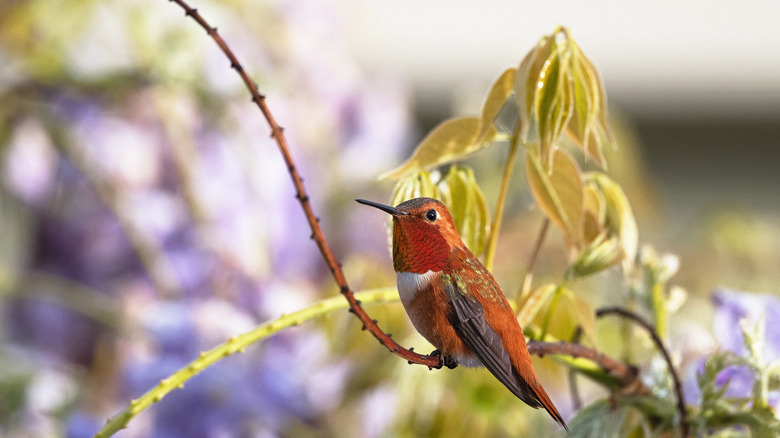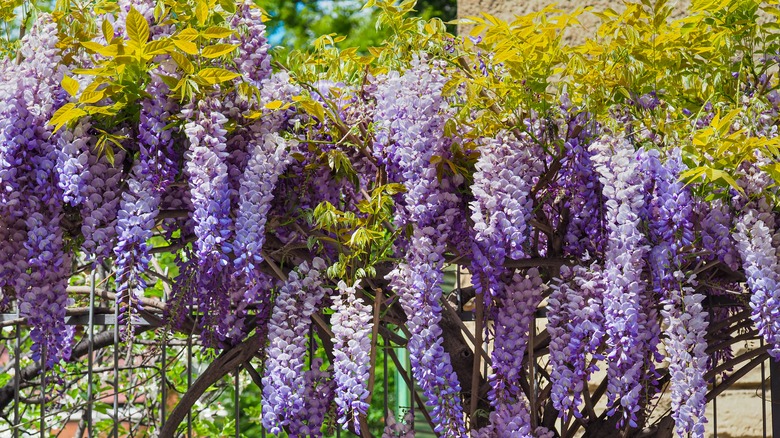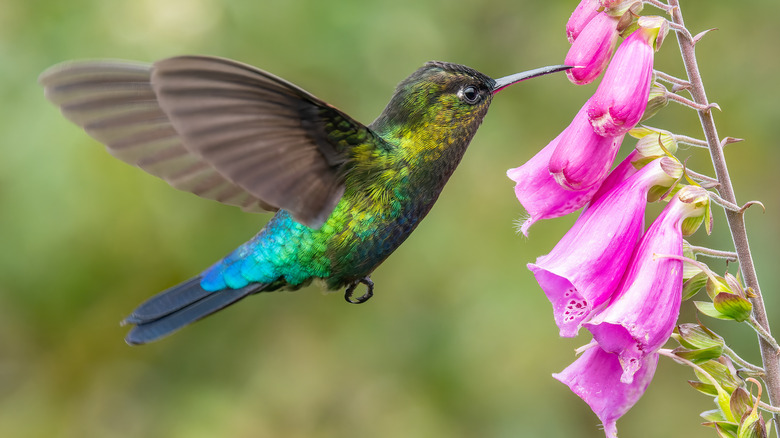Attract Hummingbirds To Your Yard With This Flowering Spring Stunner
Hummingbirds are elusive — unless you know what to plant. Just like bees, hummingbirds are pollinators. These tiny creatures fly from flower to flower, drinking nectar and pollinating each one with their wings. Attracting hummingbirds to your yard is easier than you may expect, especially with the help of a plant called Blue Moon wisteria. Planting wisteria can attract hummingbirds, bees, and butterflies. While hummingbirds are typically attracted to red, orange, yellow, and pink flowers, they are also drawn to the sweet-scented blooms of wisteria. These blooms are high in nectar and release a strong fragrance from their cascading flowers that can help attract pollinators.
Blue Moon wisteria is a climbing vine that can survive freezing temperatures of -40 degrees Fahrenheit. Because of this, it flourishes in a wide range of environments. But, wisteria has an aggressive growth habit and can quickly get out of control if not properly taken care of. Although Blue Moon is considered less invasive in its growth pattern than the Japanese cultivar, it's still best not to plant it too close to any structural foundation.
Where should I plant Blue Moon wisteria to attract hummingbirds?
Blue Moon is a non-invasive American cultivar, unlike international cultivars like Chinese and Japanese wisteria. Because it's a climbing vine, you'll want to plant it along somewhere like a fence or, as you may have seen before, near a pergola or arch. These are perfect areas for it to take its natural form and attract hummingbirds. If you don't plant it along an area it can climb, it will attach itself to whatever is nearby. This could be stems of other plants, trees, or house structures. It can easily damage foundations and septic lines if not maintained.
Blue Moon grows anywhere from 15 to 25 feet high and 6 to 8 feet wide and does best in full sun, well-draining soil, and USDA Zones 4 to 9. You can find Blue Moon wisteria at Fast Growing Trees for about $70. This 2-gallon vine blooms once in the spring and twice in the summertime. So, you have multiple opportunities to attract hummingbirds.
Getting the most out of your hummingbird-attracting garden
Blue Moon wisteria is a great way to attract hummingbirds to your yard this spring. In addition, you can also plant pollinator plants high in nectar. Like wisteria, these nectar-rich plants help attract pollinators with fragrance and provide them with food. These include beardtongue, bee balm, columbine, catmint, foxglove, lantana, scarlet trumpet honeysuckle, and summer phlox. Most of these plants also grow in similar areas to wisteria. They grow best in USDA Zones 3 to 9 and will grow in almost every part of the lower United States.
When selecting nectar-rich and pollinator-attracting plants, you'll want to make sure they bloom throughout the time hummingbirds appear in your area. In many places, this is typically spring to the end of summer and sometimes early fall. In some areas where it's warmer, hummingbirds stay year-round. In other areas where temperatures drop, they typically migrate to warmer climates. During the spring months, plants like columbine, scarlet trumpet honeysuckle, and beardtongue begin to bloom, offering a rich source of nectar to early-arriving hummingbirds. Bee balm and foxglove help sustain hummingbirds throughout the summer. Toward the end of summer and beginning of early fall, lantana, catmint, and summer phlox continue to bloom, providing sustenance to migratory hummingbirds. Planting a variety of nectar-rich plants, like wisteria, beardtongue, catmint, and foxglove, can help you create a sweet-scented and colorful garden to attract hummingbirds this spring.


